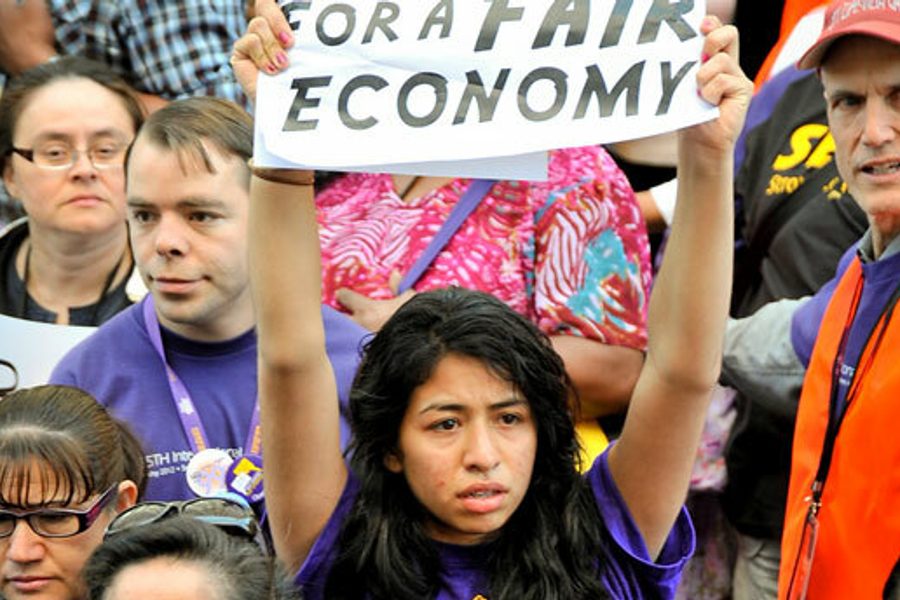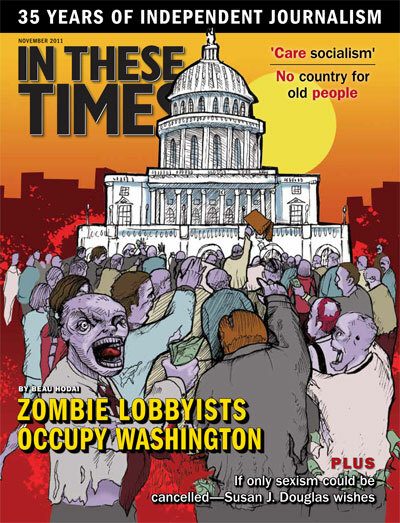Will Obama’s Job Plan Save His?
Obama’s proposed jobs bill is doomed—but it could help secure re-election.
David Moberg

The major challenge facing the country – as well as the primary obstacle to President Barack Obama’s re-election next year – is jobs. No president since Franklin Roosevelt has won re-election with the official jobless rate as high as it is now: 9.1 percent.
Even if Obama’s new jobs bill, which was proposed in September, did not face a stone wall of Republican opposition (it died in the Senate in early October), it would not solve America’s economic problems. But the ideas in the plan, which the president is now advancing through separate, piecemeal bills, could make enough of a difference to swing a close race. The president proposed a combination of infrastructure spending, school renovation, financial aid to prevent layoffs of state and local government workers, extended and reformed unemployment compensation, payroll tax deductions, and business tax incentives to hire new employees. Higher taxes on the rich and big corporations and wide-ranging budget cuts in years to come would pay for the short-term deficit.
The plan could generate around 1.9 million jobs next year, raise GDP growth by as much as 2 percent and cut one point off the unemployment rate, estimates Moody’s Analytics economist Mark Zandi. (About 25 million Americans are looking for full-time work.) Robert Johnson, executive director of the Institute for New Economic Thinking, calculates that Obama’s plan if implemented would boost Obama’s popular vote by 1.34 percentage points, a small but not insignificant edge.
Of course, with their single-minded focus on defeating Obama and controlling both houses in Congress, Republicans most likely will continue to block the most effective job-creating initiatives. In mid-October Republican senators blocked the first bill to be salvaged from the ashes of Obama’s original jobs plan, which would have provided state governments with $35 billion to forestall layoffs of teachers, police officers and firefighters. The next pared-down bill, a $60 billion infrastructure investment package, is expected to face fierce opposition when it goes to vote in late October. Both smaller bills would have been financed by tax increases on income of over $1 million.
Republicans are willing to promote policies that could worsen unemployment, hoping to prevail in negotiations with the White House. For example, House Speaker John Boehner (R-Ohio) pushed – unsuccessfully – for ending a successful job-creating initiative developing the next generation of efficient cars as a trade-off for disaster relief appropriations.
Keynes vs. Friedman
Yet beyond the cynical Republican calculation that a worsening economy will help them politically, the next election could shape up as a battle of ideas. Boehner describes Republican meetings with the president as encounters between groups “from two different planets.”
Obama’s planet operates with parts of a circumscribed, watered-down version of the ideas of John Maynard Keynes, whose analysis of managing an economy for full employment deeply influenced industrial nations’ policies during the post-World War II “golden age” of capitalism.
Boehner’s planet runs on old, visceral right-wing sentiments and a long- held business antipathy toward the New Deal. It also relies on a revival and narrowed revision of classical free market economics. In Britain and the United States, the stagflation of the 1970s boosted the influence of such key theoreticians of what is now called neoliberalism as Friedrich Hayek and Milton Friedman, who sought to minimize government and rely on deregulated markets. In this neoliberal worldview, government can do nothing good to influence business cycles, and anything it tried would just make matters worse – except cutting taxes and deregulating.
Margaret Thatcher and Ronald Reagan rode to victory on this distrust of government. Since then the conversation in both parties and nationally has drifted to the right, despite much public opinion polling showing strong majority support for progressive ideas (though not always paying for them).
Some progressive economists, like James Galbraith and Dean Baker (author of the recent book The End of Loser Liberalism) make the case that this “free market” conservatism in practice structures the market and frames government policy to help big corporations and the rich. yet neoliberal rhetoric of self-serving individualism, deregulation and free markets still undermines a sense of social solidarity, as evidenced in the Tea Party movement’s rejection of compassion and solidarity, starting with the housing foreclosure crisis.
The Republican presidential candidates all see themselves as continuing this “free market” conservatism, but they are all far to the right of their heroes. Flamboyantly expressing a common view among the contenders, Texas Gov. Rick Perry condemns Federal Reserve chairman Ben Bernanke as “treasonous” for trying to stimulate the economy, despite the fact that Friedman blamed the Great Depression on the Fed’s reluctance to bail out failing banks (and argued the central bank should have pursued a policy like Bernanke’s recent “quantitative easing”). They want to end “Obamacare,” but Hayek favored government social insurance protection against unpredictable misfortune. Barry Goldwater supported gay rights, and Reagan eventually raised taxes – neither popular stances with Republican leaders.
Meanwhile, the Obama administration largely follows Bill Clinton’s soft-edged capitulation to the neoliberal model. New America Foundation economist Thomas Palley, author of From Financial Crisis to Stagnation: The Destruction of Shared Prosperity and the Role of Economics (January, Cambridge University Press), describes the still-dominant New Democratic policies as “emergency Keynesianism” wedded to “helping hand neoliberalism.”
When the crisis hit in 2008, a more robust Keynesianism, still advocated by the labor-progressive wing of the Democrats, seemed ready for revival. Not only were major capitalist institutions near collapse, but apologists for deregulation, such as former Fed chairman Alan Greenspan, admitted they were wrong on many counts.
Though he was pointedly not a socialist, Keynes advocated far more ambitious action than just deficit spending to stimulate jobs and growth. He famously argued for “euthanasia of the rentiers” (rough translation: get rid of financial speculators) and “socialization of investment” (using public policy to maximize productive investment).
Palley argues that today’s crisis demands a “structural Keynesianism” that will rebuild the engine of economic growth, which he calls the “demand generating process.” Neoliberalism destroyed the successful post-World War II system in the U.S. by promoting labor market flexibility, globalization, and small government and by abandoning the goal of full employment, Palley argues.
Neoliberal policies increased inequality, broke the link between rising productivity and rising living standards, destroyed unions, crippled or off-shored much of the manufacturing sector, and promoted both financialization and the corporate power, Palley writes.
Structural Keynesianism would resurrect government’s role (investment, regulation, progressive taxation), promote both labor market solidarity (including more equality at work) and full employment, and manage globalization. Taken together, the policies would steer corporations and financial markets towards serving the public good.
Ron Blackwell, chief economist of the AFL-CIO, shares Palley’s view that the Great Recession marks a crisis of neoliberalism, not just another, deeper downturn. The nation needs a new system for encouraging innovation that will strengthen the U.S. position in the world economy, he says. And both the national and global economies are out of whack: trade imbalances (including the U.S. deficit) are unsustainable; finance has undue dominance over the real economy; and the balance of power between works and employers has shifted overwhelmingly to the employers.
A glimmer of rhetorical hope
Rhetorically, Obama seemed ready to tackle both the short-run crisis and many of the longer-range challenges, such as greening the economy. But the right has managed to turn the debate from market failure and inadequate aggregate demand to government failure and the threat of budget deficits. They have succeeded with a consistent, simple message, bolstered by a disregard for facts, that appeals to the lesser devils of human nature, at a time when their Democratic opponents have lost resolve and direction.
Beyond that, Obama had the disadvantage of taking office in the equivalent of 1929, not 1932, like Roosevelt. At the time it was hard to fathom the likely depth of the crisis, and despite many calls for a bigger stimulus, the administration – under influence of advisors like Larry Summers and Treasury Secretary Geithner, but with Obama’s full approval – took a more modest step and over-optimistically miscalculated the unemployment rate target.
Though the actions averted greater crisis by saving and creating millions of jobs, Economic Policy Institute president Larry Mishel says that most people did not see the link between government action and jobs. Unemployment continued to rise, and the stimulus averted even worse joblessness – but no one saw the disaster avoided. Also, there were relatively few visible examples of public money creating jobs, unlike the WPA or CCC projects in the 1930s. And the right pronounced it a failure before it even started.
Yet, to take one example, Obama’s green initiatives created or saved nearly a million jobs through 2010, while promoting efficiency and alternative energy, according to a study by EPI and the Bluegreen Alliance. But the right has seized on the collapse of Solyndra, a solar cell manufacturer that received a loan guarantee, to argue the program – and all government industrial policy – is a failure.
Never mind that many other green projects are apparently thriving or that Obama’s biggest industrial policy gamble saved the auto industry. Or that many savvy private investors also put money into Solyndra, and that the company’s problems partly reflected China’s aggressive entry into the field as well as falling prices for silicon, making Solyndra’s alternative less competitive. EPI also found that other right-wing attempts to blame Obama for unemployment are flawed: “Regulatory uncertainty” does not explain why cash-rich, highly profitable businesses are not investing more, and all proposed and final environmental rules together cost about one-tenth of a percent of GDP but yield even more benefits.
Many people conflated the stimulus and the unpopular bank bailout started under Bush. The bailout saved the banks, averting a worse crisis, but did not punish culprits or transform banks to serve the economy. Now, University of Massachusetts at Amherst economist Robert Pollin argues, the banks are sitting on more than $1.4 trillion in cash (equal to 10 percent of GDP), most of which they could invest while still holding greater reserves than are legally required. Meanwhile, bank profits and salaries have soared since the crisis, as banks are denying around 60 percent of small business loan applications. (Pollin suggests taxing excess reserves to spur lending.)
The president’s political future is in jeopardy thanks to the severity of the crisis, the modest ambitions of his initial policies, and the Republican right’s flat-out rejection of Keynesianism. Yet as he pushes his jobs agenda and holds Republicans accountable for foiling job creation, Obama is rhetorically linking Keynesian policy with a populist political message. By doing so, he could help reverse the huge enthusiasm gap between dispirited Democratic voters and energized Republicans. And, not so incidentally, he will also be a pursuing a significant – if not wholly sufficient – part of the policy the country needs.
A shorter version of this article appeared in print.
David Moberg, a former senior editor of In These Times, was on staff with the magazine from when it began publishing in 1976 until his passing in July 2022. Before joining In These Times, he completed his work for a Ph.D. in anthropology at the University of Chicago and worked for Newsweek. He received fellowships from the John D. and Catherine T. MacArthur Foundation and the Nation Institute for research on the new global economy.









